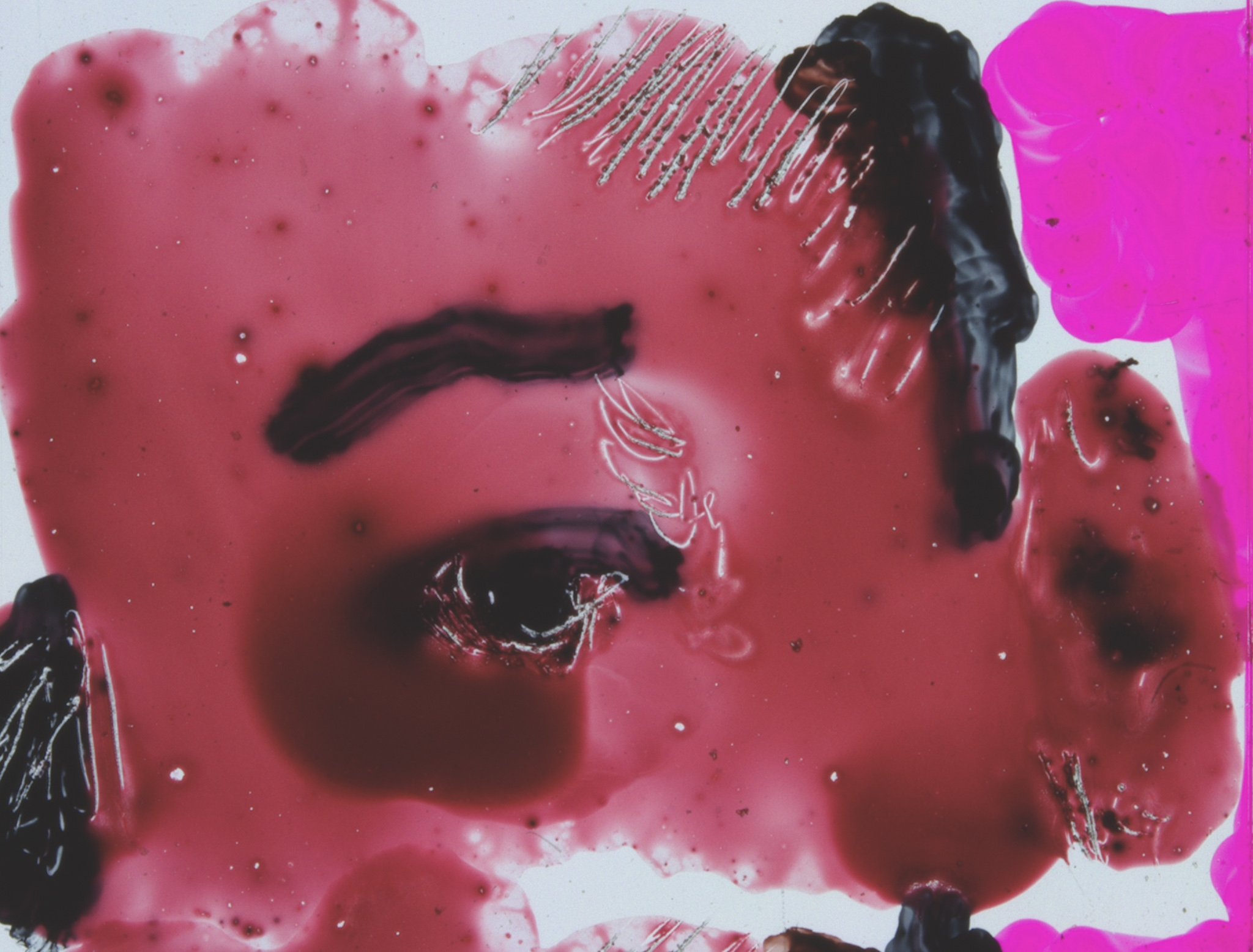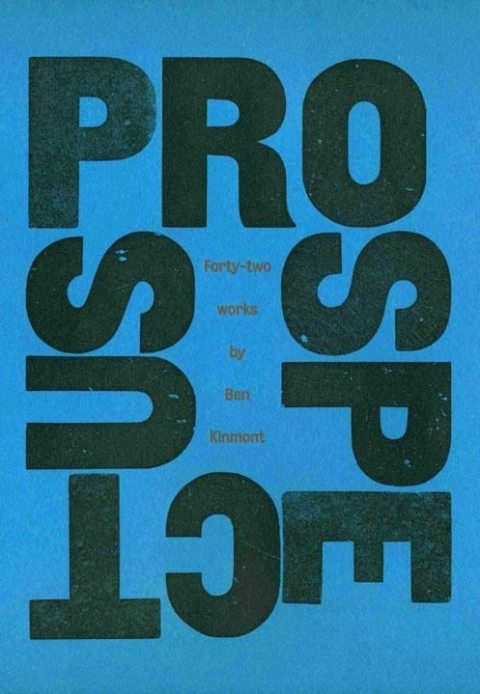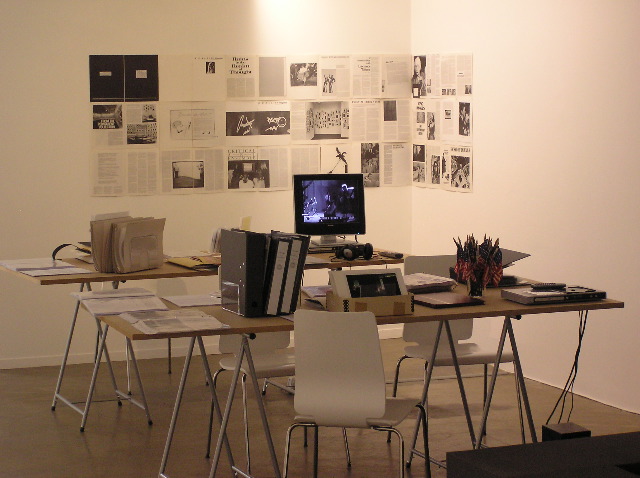
© » KADIST
Mathieu Abonnenc
Secteur IX B is full of ghosts: some that you can see, briefly appearing at the turn of a statue in an under construction museum, some that you only dream of when you switch from day to night, of one space to another. Mathieu Kleyebe Abonnenc invites us to follow a main character, Betty, an ethnographer currently leading research in the archives of the Theodore Monod Museum for African Arts, in Dakar. Punctuated by an anguished soundtrack and borrowing tropes from thriller genre films to create a sense of oddity, the film comments on the contemporary effects of colonial legacy in cultural institutions.

© » KADIST
Fredi Casco
Drawing & Print (Drawing & Print)
Pascua Dolorosa (Painful Easter) by Fredi Casco is a series of drawings made on old worksheets documenting land surfaces in Caapucú, a forest exploitation area where one of the most violent episodes of the repression of Stroessner’s dictatorship took place in 1976, and during which peasants accused of belonging to insurgent movements were kidnapped, tortured and many of them killed. In 2009, human bone remains were found in the Caapucú region during ground measurement work. These works reveal the tension between a cold and positivistic approach to landscape as put on record in the legal papers, the poignant use of violence as inscribed into the land, and a ghostly invocation of the power of resistance.

© » KADIST
Voluspa Jarpa
To make Minimal Secret (2012), Jarpa created sculptures based on pages of declassified CIA information about the United States’ involvement in Chile. The cutouts in the acrylic represent the content that was blacked out when the pages were released to the public. For Jarpa, that so much content from these documents was deleted before declassification is symptomatic of hysterical behavior, which, in Freudian psychoanalysis, results from the inability to deal with trauma.
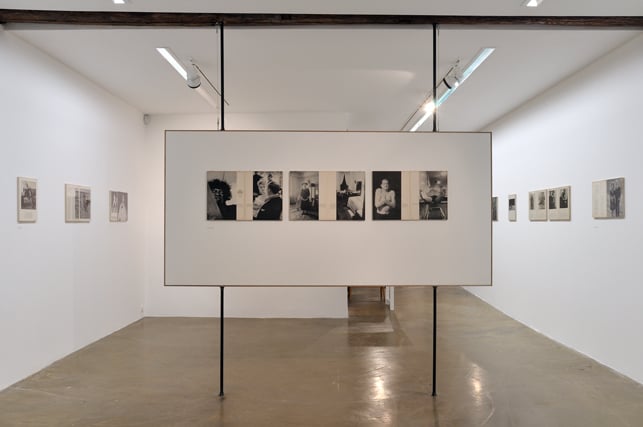
© » KADIST
Pierre Leguillon
End of 2008, Pierre Leguillon presented at KADIST, Paris the first retrospective of the works of Diane Arbus (1923-1971) organized in France since 1980, bringing together all the images commissioned to the New York photographer by the Anglo-American press in the 1960s. This exhibition, destined to tour in various locations, presents the original pages of the magazines, including “Harper’s Bazaar”, “Esquire”, “Nova” and “The Sunday Times Magazine”. As Pierre Leguillon states: “The mythology surrounding Diane Arbus’ character is willingly set aside to offer a more neutral point of view on a more unfamiliar part of her work, although it was mass-distributed.” Many of the characters portrayed in these commissioned works seem less sensational at first glance than the “freaks” that made Diane Arbus’ work so famous, since the retrospective MOMA organized in 1973 in New York, two years after her suicide.

© » KADIST
Diego Marcon
Monelle by Diego Marcon was filmed at night inside the infamous Casa del Fascio, the headquarters of the local Fascist Party in Como Italy, designed by Giuseppe Terragni under Mussolini’s rule. The building is immersed in darkness and it is initially difficult to recognize the iconic rationalist architecture, flashes of light illuminate languid adolescent girls sleeping amidst the space for just a few seconds at a time. Next to the bodies, strange humanoids are lurking, they are CGI-generated, but the human eye does not have enough time to register their artificiality, they materialize and disappear in a flash like ghosts.

© » KADIST
Daniel Gustav Cramer
Drawing & Print (Drawing & Print)
David Gustav Cramer’s are composed of simple, descriptive texts accompanied by found photographs, letters or other materials. The elements juxtaposed in each work operate like the lines of a Haiku. It is the tension between them that opens space for thought.

© » KADIST
Jill Magid
In 1995, the personal and professional archives of the Mexican architect Luis Barragán were acquired (including the rights to the name and the work of the architect) by the Swiss furniture enterprise Vitra. Frederica Zanco, wife of the owner of Vitra, had received these archives as an engagement present, rather than a solitaire diamond. In this video, The Exhumation , the artist poses the question: how to navigate the laws that render Barragán in public space?

© » KADIST
Benoît Maire
The series Clouds paintings by Benoît Maire features oil on canvas works in varying format, in which the artist depicts clouds, using a variety of tools, including a spray gun, paintbrush, or palette knife. The cloud motif in this series of paintings questions the limits of abstraction by playing with the concept of pareidolia—a psychological phenomenon by which we recognize familiar shapes in landscapes, clouds, or ink stains. Through his careful composition and use of pentimenti, Maire invites the viewer to project their imagination onto these colorful clouds.

© » KADIST
Fehras Publishing Practices
Borrowed Faces is a photo novel published in 2019. These framed colour photographs are selected scenes from the novel. They mimic the aesthetic of a dated comic strip but instead contain vibrantly coloured, digital photos; here the ‘live’ element of the photographic medium meets the theatrics of the graphic novel.

© » KADIST
Joana Hadjithomas & Khalil Joreige
Rocket Society refers to a space project led by a group of Armenian researchers at the beginning of the 1960s. They created the first Middle Eastern rocket and carried out a dozen launches. Today, there is a kind of amnesia related to this space program while at that time the newspapers would talk about it frequently; a postal stamp was even issued for the occasion.

© » KADIST
Ben Kinmont
The archive proposes to examine the difference between helping others in the context of an artistic project and in the context of social work in order to question authorship. The first part of Digger Dug made in 2004 was reactivated during the Kadist exhibition, for instance as an exchange with an anthropologist concerning ethics in projects that are both artistic and social. Thus the archive contained a new text and a series of photographs, videos and notes made during the exhibition.
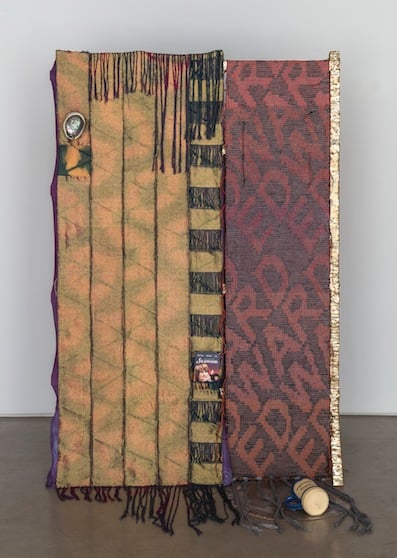
© » KADIST
Josh Faught
Some of Faught’s works have been inspired by the ad hoc monuments created at gravesites in San Francisco’s Neptune Society Columbarium, where many victims of the AIDS epidemic were laid to rest. The personal objects, mementos, and offerings left in the cemetery have become something of an archive of a particular moment in queer history and the gay community in the city. His 2014 sculpture, Edward , is part of a larger series of works that Faught has made to memorialize (or simply recall) his past lovers.

© » KADIST
Nguyen Trinh Thi
Landscape Series no. 1 presents landscape as a “quiet witness of history.” It began with searches of online archives of Vietnamese news-media, for images of figures in landscapes “pointing, to indicate a past event, the location of something gone, something lost or missing.” The uniformity is striking but the sequence is subtly structured: the typology hints at narrative progression, though of an uninformative narrative, lacking details.

© » KADIST
Pauline Boudry and Renate Lorenz
Salomania sees choreographer and filmmaker Yvonne Rainer and artist Wu Tsang rehearse scenes from Valda’s Solo , a chapter of a film Rainer made in 1972 after having seen women perform the dance of the seven veils in Alla Nazimova’s 1923 silent film Salomé . The script is based on the Biblical New Testament story of the Jewish princess Salomé, who in the Christian tradition has been depicted as an emblem of feminine seduction and danger. In the twentieth century, her character was made popular through English playwright Oscar Wilde’s famous theater piece, Salomé .

© » KADIST
Naresh Kumar
Drawing & Print (Drawing & Print)
“Relation between Black and blood” explores the connection between performance, installation and representation. The artist’s use of watercolour is inherited from Mughal miniature painters who migrated from Delhi to the East India Company on the Ganges for the opium trade. The Miniaturists used cheaply available transparent Mica to paint images of the water carrier, the cobbler, dancers, prostitutes, wanderers and god men.

© » KADIST
Ahmad Fuad Osman
Recollections of Long Lost Memories by Ahmad Fuad Osman is a series of 71 black and white sepia-toned archival photographs that chart, with nostalgia, the social encounters between hierarchies of life in the Malay world. It begins with British colonial rule in the mid 1800s, followed by its occupation by Japanese forces in the 1940s, the rise of Communism in the 1950s, and then the racial issues between Islamic, Chinese, and Indonesian populations in a multicultural country desiring political independence in the 1960 and 70s. The archival photographs in this series were gleaned from national archives, museums, libraries, and old books across Malaysia.

© » KADIST
Rebecca Quaytman
R. H. Quaytman’s family on her father’s side is of Jewish heritage from Poland. In the summer of 2016, Quaytman traveled to Poland to research an upcoming retrospective exhibition taking place in Warsaw and ?ódz, the town from which her great-grandfather emigrated to the United States. Tracing her grandfather’s and great-grandfather’s origins, Phocis Pole is from a series of paintings that explores her paternal lineage.

© » KADIST
biarritzzz
biarritzzz is interested in how the development of the internet, and experimentation in the virtual world happens simultaneously with the experimentation in the material world of the human species; and how these developments reflect the precariousness of life within neoliberalism. The title of their video work Mandacura is a corruptela (a linguistic distortion on writing or pronunciation) of the Portuguese sentence Mão da Cura (Healing Hand), distorting Portuguese into what sounds as Brazilian Afro-Indigenous. Inspired by and using the music and poetry of Alberto Marques, and drawing sources from archival images, webcam videos, screenshots, gifs and memes, the video asks: What provokes our feelings toward society, history, culture, and the future?

© » KADIST
Jiri Kovanda
Drawing & Print (Drawing & Print)
All Kovanda’s artistic practice poses the question of visibility. Having worked on actions and performance, the artist decided to ‘disappear’ from his artworks during twenty years; in 2007, his performance Kissing through glass in the institutional setting of Tate Modern was acclaimed by critics. Some works are only visible thirty years later via traces and archives; the artist’s rehabilitation by institutions and galleries offers a new critical reading of his practice which had until then remained rather confidential.

© » KADIST
Akram Zaatari
“Films inspired people a lot. they came to perform kissing in front of a camera. In a conservative society such as Saida, people were willing to play the kiss between two people of the same sex, but very rarely between a man and a woman.
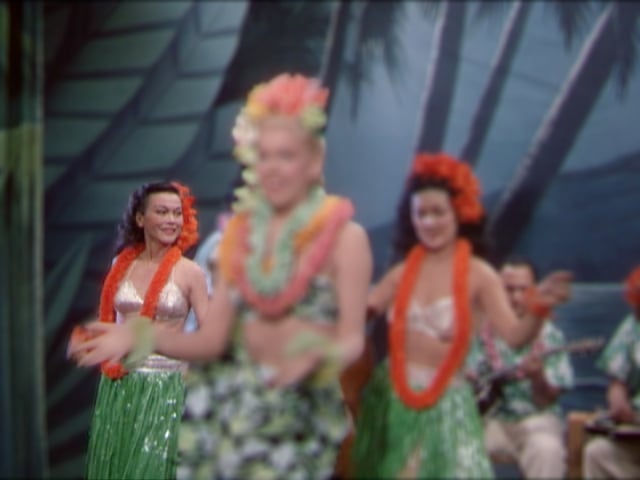
© » KADIST
Miljohn Ruperto
Miljohn Ruperto’s silent video work Appearance of Isabel Rosario Cooper is an archive of ghosts. The video’s title figure, a Filipina actress, vaudeville dancer and singer who played racialized, peripheral roles in Hollywood in the 1940s and 1950s, flits in and out of a montage of scenes. Ruperto digitally modified the 16mm film by blurring the background and all of the figures in each scene except for Cooper herself.

© » KADIST
William E. Jones
Killed is a video projection in which William E. Jones appropriated and edited, in a rapid sequence, a selection from the more than 68,000 censored or discarded films produced by the Farm Security Administration’s photographers between 1935 and 1943. Roy Emerson Stryker, the then director of the program, was in charge of what he called “killing” negatives by punching holes in them to render them unusable. Killed continues Jones’s use of discarded film footage seen in his video created from vintage 1970s and 1980s gay porn that was included in the 2008 Whitney Biennial.
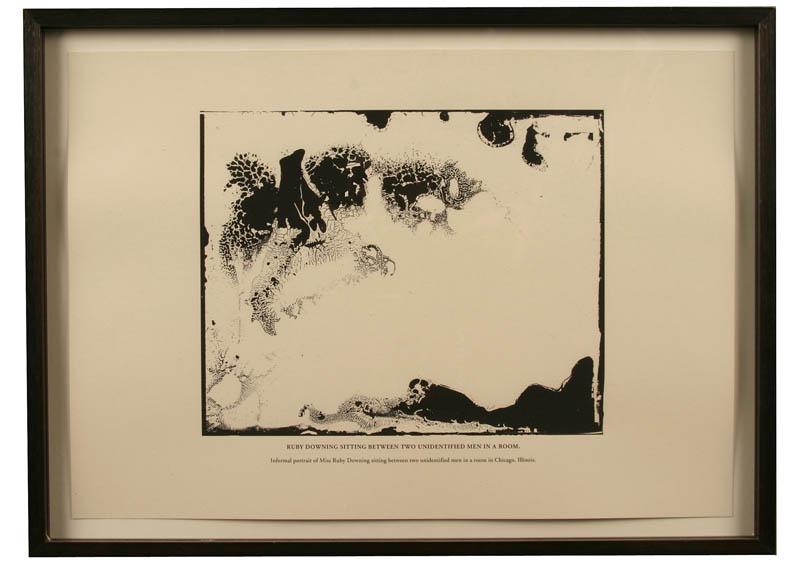
© » KADIST
Lisa Oppenheim
Drawing & Print (Drawing & Print)
The Damaged series by Lisa Oppenheim takes a series of selected photographs from the Chicago Daily News (1902 – 1933) as its source material. For this project, Oppenheim procured the original glass negatives, which had been damaged over time, from the archives of this newspaper. She then printed the negatives as is, highlighting the multitude of physical flaws that had ‘spoiled’ the negatives.

© » KADIST
Lisa Oppenheim
Drawing & Print (Drawing & Print)
The Damaged series by Lisa Oppenheim takes a series of selected photographs from the Chicago Daily News (1902 – 1933) as its source material. For this project, Oppenheim procured the original glass negatives, which had been damaged over time, from the archives of this newspaper. She then printed the negatives as is, highlighting the multitude of physical flaws that had ‘spoiled’ the negatives.

© » KADIST
Lisa Oppenheim
Drawing & Print (Drawing & Print)
The Damaged series by Lisa Oppenheim takes a series of selected photographs from the Chicago Daily News (1902 – 1933) as its source material. For this project, Oppenheim procured the original glass negatives, which had been damaged over time, from the archives of this newspaper. She then printed the negatives as is, highlighting the multitude of physical flaws that had ‘spoiled’ the negatives.
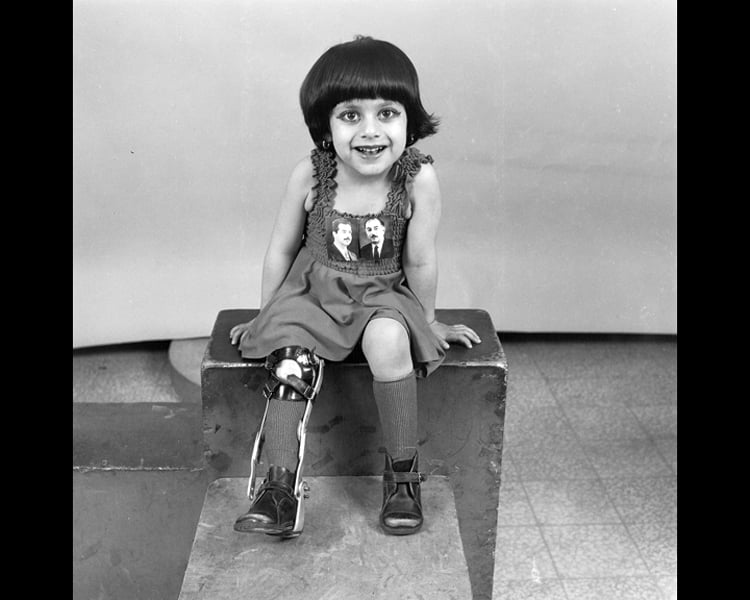
© » KADIST
Akram Zaatari
“In the 1980s I started using coloured paper backdrops, one of which was yellow. You can see they never reached the floor. I used them for colour and black-and-white photography.” Hashem El Madani.

© » KADIST
Jeremy Deller
Beyond the White Walls , with a commentary written and spoken by Jeremy Deller, is often wryly amusing. The artist narrates the many projects he has completed or which are in progress beyond the gallery walls. It is beyond the gallery where Deller is at his most effective and where his art reaches out to and into people’s lives.

© » KADIST
CAMP
The Annotated “Gujarat and the Sea” Exhibition is a collateral project within the larger body of work around the Indian Ocean, entitled “Wharfage” (2009-13) which has included over the years a radio event, several books and a film. “Boat Modes” (2009-12) dealt with the modalities of maritime life on ships and in ports between UAE, Southern Iran, India and Somalia, using photographs, texts and film based on mobile phone videos made by sailors. CAMP sees this work as a kind of historical intervention on the same subject.

© » KADIST
Mungo Thomson
Drawing & Print (Drawing & Print)
The White Album (2008) presents a compilation of one hundred issues of Artforum magazine released between 1970 and 1979. As with Will Rogan’s MUM series, also included in the Kadist Collection, vital information is now missing: All of all the articles and features have been removed, leaving only ten years of advertisements. In an unusual way, The White Album reminds us that this important New York-focused magazine was originally founded in 1962 in San Francisco to promote Bay Area artists before it moved to Los Angeles in the mid-1960s in search of a wider advertising base.
Lisa Oppenheim
- location: New York, New York
- year born: 1975
- gender: female
- nationality: American
- home town: New York, New York
Akram Zaatari
- location: Sayda, Al-Lubnan
- year born: 1966
- gender: male
- nationality: Lebanese
Voluspa Jarpa
Voluspa Jarpa’s work is based upon a meticulous analysis of political, historical, and social documents from Chile and other Latin American countries, which she uses to develop a reflection on the concept of memory...
Xaviera Simmons
- location: Brooklyn, New York
- year born: 1974
- gender: female
- nationality: American
- home town: New York, New York
Ahmad Fuad Osman
Ahmad Fuad Osman is of a generation that came of age in a Malay world whose artists were eager to speak about socio-political issues on terms that broadened questions of nationhood, ethnicity, faith, and historical fact, doubtful of the grand narrative that had been propounded since the race riots of the late 1960s...
Pierre Leguillon
Pierre Leguillon is an artist who has developed projects as a curator and critic since the beginning of the 1990s, by creating a single page review, ‘Sommaire’ (35 issues between 1991 and 1996), then by collaborating to ‘Journal des Arts’, and ‘Art press’ (Special issue « Oublier l’exposition » in 2000), then to ‘Purple’ (column « Calme plat » about printed objects from 2002 to 2004)...
Diego Marcon
Diego Marcon uses film, video and installation to investigate the ontology of the moving image, focusing on the relationship between reality and representation...
Josh Faught
American artist Josh Faught uses weaving, knitting, and crochet as means to making in his textured and evocative sculptures...
Fehras Publishing Practices
Fehras Publishing Practices is a collective founded by Sami Rustom, Omar Nicolas and Kenan Darwich that was established in 2015...
Jeremy Deller
- location: London, United Kingdom
- year born: 1966
- gender: male
- nationality: British
Fredi Casco
Working with a variety of media such as drawing, painting and photography Fredi Casco frequently incorporates original documents and archives as a medium and support of his work in order to bring to light specific episodes of Paraguayan political history, particularly events that took place during the time of Alfredo Stroessner’s long dictatorship (1954 to 1989)...
Pauline Boudry and Renate Lorenz
Working together since 2007, artist duo Pauline Boudry and Renate Lorenz conduct research on the heritage of cultural and gender studies, concentrating primarily on gender discourses and the notion of queer...
CAMP
CAMP is an artistic collective that started working as a group in 2007, initially consisting of Shaina Anand (filmmaker and artist), Sanjay Bhangar (software programmer) and Ashok Sukumaran (architect and artist)...
Jiri Kovanda
- location: Praha, Ceská Republika
- year born: 1953
- gender: male
- nationality: Czech
biarritzzz
biarritzzz is a Brazilian artist who inserts epistemological conversations through mass communication, specifically on and from the internet...
Jill Magid
Jill Magid is a conceptual artist specialising in the infiltration of control organs and power systems...
Nguyen Trinh Thi
Nguyen Trinh Thi is a moving image pioneer, not only within the landscape of contemporary art in Vietnam, but also broader South East Asia...
Naresh Kumar
Naresh Kumar (b...
Mungo Thomson
- location: Los Angeles, California
- year born: 1969
- gender: male
- nationality: American
Joana Hadjithomas & Khalil Joreige
Joana Hadjithomas and Khalil Joreige collaborate as both filmmakers and artists, producing cinematic and visual artwork that intertwine, spanning feature and documentary films, video and photographic installations, sculpture, performance lectures and texts...
Rebecca Quaytman
In her work, Rebecca Quaytman displays great interest in the dissolution of the image...
Jason Fulford
Photography and book publishing are inextricable in the work of Jason Fulford...
Mathieu Abonnenc
Mathieu Kleyebe Abonnenc’s practice engages with the cultural hegemonies that form the basis for the evolution of contemporary society...
Miljohn Ruperto
- location: Los Angeles, California
- year born: 1973
- gender: male
- nationality: Filipino and Danish
- home town: Manila, Philippines
Ben Kinmont
Since the late 1980s Ben Kinmont has been interested in interpersonal communication as a means of addressing the problems of contemporary society...
-
1950-1959
Akram Zaatari
1950“In the 1980s I started using coloured paper backdrops, one of which was yellow...
-
1970-1979
Jiri Kovanda
Drawing & Print
1977(Drawing & Print) All Kovanda’s artistic practice poses the question of visibility...
-
2000-2009
Lisa Oppenheim
Drawing & Print
2003(Drawing & Print) The Damaged series by Lisa Oppenheim takes a series of selected photographs from the Chicago Daily News (1902 – 1933) as its source material...
Lisa Oppenheim
Drawing & Print
2003(Drawing & Print) The Damaged series by Lisa Oppenheim takes a series of selected photographs from the Chicago Daily News (1902 – 1933) as its source material...
Lisa Oppenheim
Drawing & Print
2003(Drawing & Print) The Damaged series by Lisa Oppenheim takes a series of selected photographs from the Chicago Daily News (1902 – 1933) as its source material...
Ben Kinmont
2004The archive proposes to examine the difference between helping others in the context of an artistic project and in the context of social work in order to question authorship...
Ahmad Fuad Osman
2007Recollections of Long Lost Memories by Ahmad Fuad Osman is a series of 71 black and white sepia-toned archival photographs that chart, with nostalgia, the social encounters between hierarchies of life in the Malay world...
Pierre Leguillon
2008End of 2008, Pierre Leguillon presented at KADIST, Paris the first retrospective of the works of Diane Arbus (1923-1971) organized in France since 1980, bringing together all the images commissioned to the New York photographer by the Anglo-American press in the 1960s...
Mungo Thomson
Drawing & Print
2008(Drawing & Print) The White Album (2008) presents a compilation of one hundred issues of Artforum magazine released between 1970 and 1979...
Pauline Boudry and Renate Lorenz
2009Salomania sees choreographer and filmmaker Yvonne Rainer and artist Wu Tsang rehearse scenes from Valda’s Solo , a chapter of a film Rainer made in 1972 after having seen women perform the dance of the seven veils in Alla Nazimova’s 1923 silent film Salomé ...
Miljohn Ruperto
2009Miljohn Ruperto’s silent video work Appearance of Isabel Rosario Cooper is an archive of ghosts...
-
2010-2019
Natasha Wheat
Drawing & Print
2011(Drawing & Print) Natasha Wheat’s Kerosene Triptych (2011) is composed of three images, one each from the digital files of the Library of Congress, the Smithsonian Institution, and the Field Museum tropical research archive...
Voluspa Jarpa
2012To make Minimal Secret (2012), Jarpa created sculptures based on pages of declassified CIA information about the United States’ involvement in Chile...
Jeremy Deller
2012Beyond the White Walls , with a commentary written and spoken by Jeremy Deller, is often wryly amusing...
Josh Faught
2014Some of Faught’s works have been inspired by the ad hoc monuments created at gravesites in San Francisco’s Neptune Society Columbarium, where many victims of the AIDS epidemic were laid to rest...
Mathieu Abonnenc
2015Secteur IX B is full of ghosts: some that you can see, briefly appearing at the turn of a statue in an under construction museum, some that you only dream of when you switch from day to night, of one space to another...
Naresh Kumar
Drawing & Print
2015(Drawing & Print) “Relation between Black and blood” explores the connection between performance, installation and representation...
biarritzzz
2015biarritzzz is interested in how the development of the internet, and experimentation in the virtual world happens simultaneously with the experimentation in the material world of the human species; and how these developments reflect the precariousness of life within neoliberalism...
Jill Magid
2016In 1995, the personal and professional archives of the Mexican architect Luis Barragán were acquired (including the rights to the name and the work of the architect) by the Swiss furniture enterprise Vitra...
Fredi Casco
Drawing & Print
2017(Drawing & Print) Pascua Dolorosa (Painful Easter) by Fredi Casco is a series of drawings made on old worksheets documenting land surfaces in Caapucú, a forest exploitation area where one of the most violent episodes of the repression of Stroessner’s dictatorship took place in 1976, and during which peasants accused of belonging to insurgent movements were kidnapped, tortured and many of them killed...
Diego Marcon
2017Monelle by Diego Marcon was filmed at night inside the infamous Casa del Fascio, the headquarters of the local Fascist Party in Como Italy, designed by Giuseppe Terragni under Mussolini’s rule...
Xaviera Simmons
2019Xaviera Simmons often employs her own body and collected materials in the service of her photographs and performances...
-
2020-2029
Daniel Gustav Cramer
Drawing & Print
2020(Drawing & Print) David Gustav Cramer’s are composed of simple, descriptive texts accompanied by found photographs, letters or other materials...



